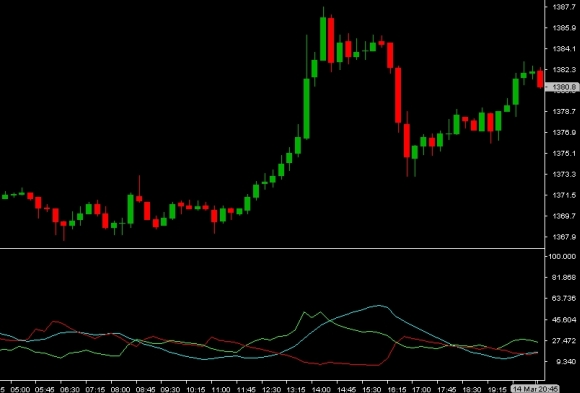ADX is an abbreviation of Average Directional Index. This indicator was created by a famous technical trader – J. Welles Wilder. First it was mentioned in his book “New concepts in technical trading systems” (year 1978). ADX is an indicator which main purpose is to identify the strength of the overall trend – doesn’t matter whether it is positive or negative. It means that high ADX values can mean raising market as well as falling market. You can imagine that as bulls and bears war. High ADX values mean that one of the groups wins most of the battles but you don’t know which of the animals it is.
The good thing is that ADX itself consist of smaller parts which can measure the strength of the positive trend and the negative trend separately. The indicator measuring positive trend is referred to as +DI (positive directional indicator), the negative trend as –DI (negative directional indicator). Their values together create DX (directional index) and ADX (average directional index). ADX values are basically just DX values that are smoothed by a moving average. That is the reason why this whole system of partial trend indicators is also called Directional movement system (DMS) or Directional movement indicators (DMI).
Most indicators are either trend-following indicators or oscillators that work best in non-trending markets (also called as ranging or choppy markets). For example, moving averages are very good and reliable technical indicators that work best when the market is in trend. It doesn’t matter whether a trader uses them for trading forex, stocks, futures, indices they are reliable on every market. On the other hand, the moving averages can produce a lot of false buying and selling signals when there is no prevailing trend. In such case the oscillators like Stochastic oscillators, Relative strength index, Williams percentage range and others are better to use for technical analysis of the market. The main problem seems to be to identify whether there is or is not any prevailing trend present and that is what ADX does.
ADX values can range from 0 to 100 points. The typical movement takes place in the range between 20 and 40 points. Values lower than 20 points mean only a weak trend. Values above 40 mean strong trend. Anyway, values above 60 points are very rare to see.
The ADX indicator is an inevitable part of almost every trading platform and its charting software as it is frequently used for technical trading. The ADX chart can look like the image below shows:

As you can see below the basic green and red candlestick chart (that reflects the price of the underlying asset, e.g. stock) there are three differently colored curves. The green curve displays the strength of the uptrend, positive trend (+DI values). The red curve shows the strength of the downtrend, negative trend (-DI values). The blue curve is the combination of the previous ones and shows the very ADX values.
ADX formula and calculation:
1. Calculate +DM (Today’s high – Yesterday’s high)
2. Calculate –DM (Yesterday’s low – Today’s low)
3. Only one of these values is valid for the current day = the higher positive value. Should both values be negative, then 0 value is valid for the current day.
4. Calculate the True range for the day. True range means the highest value of the following: (Today’s high – Today’s low) vs. (Today’s high – Yesterday’s close) vs. (Yesterday’s close – Today’s low).
5. Calculate +DM14 which means Wilder’s moving average of the Positive values from the last 14 days (Wilder used his own, specific calculation of moving average that is quite close to Exponential moving average).
6. Calculate –DM14 which means Wilder’s moving average of the Negative values from the last 14 days.
7. Calculate TR14 which is Wilder’s moving average of the True range from the last 14 days.
8. Calculate +DI14 which means +DM14 divided by TR14.
9. Calculate –DI14 which means +DM14 divided by TR14.
10. Calculate the DI difference, i.e. the absolute value between +DI14 and –DI14.
11. Calculate the Directional index (DX) which is the DI difference divided by the sum of +DI14 and –DI14 absolute values
12. Calculate ADX which means the Wilder’s moving average of Directional index (DX).
Practical use for trading:
As stated before, values lower than 20 points indicate only a weak trend. That is the reason why it is better to focus on ranging oscillators like Schaff trend cycle, Accumulative swing index, Commodity channel index etc. Higher values mean a strong trend on the market so it is better to use trend-following indicators like MACD, KAMA, Donchian channel, Detrended price oscillator etc.
Moreover, as the complete Directional movement system can also identify the prevailing trend – whether it is positive (+DI) or negative (-DI), technical trader can use this information for choosing the trades just in line with the stronger trend. A trader can also search for beginning of a new trend as these signals can be the most profitable ones. Keep in mind that traders waiting for new (and long lasting) buy signals should search for +DI crossing the –DI upwards and traders that wait for new signals to go short should search for +DI crossing the –DI downwards – both crossings mean that one of the indicators (either positive or negative) has just gained momentum and begun to dominate. Should the +DI and –DI move sideways, close each other then there is no prevailing trend on the market. Similarly, should the +DI and –DI values becomes closer (they converge) the present market trend probably weakens. Should the +DI and –DI values begin distance themselves (they diverge) a new strong trend could just started.
Generally, if a trader does not want to make trades based on the positive and negative directional indicators and use any other indicators instead (either trend-following indicators or some of the oscillators used for trading ranging markets) he could follow just the ADX values. Then if the ADX values cross the 20 point level upwards, it can be a signal that a new, strong trend could just begin and trader should use one of the trend indicators. Such traders should also become very cautious when the previous high ADX values cross the 40 point level downwards. It can help them to identify moments when trends come to their end. An alternative to ADX (as a trend measuring technical indicator) can be used e.g. Aroon indicator. Despite the Aroon indicator is not so famous and popular as ADX is, it has some nice features a trader could consider for being helpful. Anyway as both these indicators identify trend strength it is not recommended to combine them within the same trading system. Another option is to use the RWI (Random Walk Index) for trend identification. Unlike ADX or Aroon, RWI can adjust periods for its calculation and can adapt to the changing conditions on the market.
High values of most technical indicators do usually mean that the market is rising and vice versa, that low values means automatically falling market. It is very important to remember, that high ADX values means just strong trend generally – it can be either positive or negative.
Finally we can repeat the trading signals and basic rules while trading with ADX.
It is best to use ADX with any other indicator – either such one that generates reliable signals based on dominating trends or such one that generated signals based on trend oscillation and frequent signal changes.
Any trader using the trend-following indicators should search for ADX crossing 20 point level upwards. That could mean a new strong trend beginning. It doesn’t tell him whether the market raises or falls his own trend-following indicator should give him the right signal to go long or short, e.g. crossings of two moving averages should work just fine.
Any trader using ranging oscillators should search for ADX crossing 40 point level downward. It could signalize end of the current trend prevailing on the market. Again – the signals to buy or sell can be generated by the added oscillator, e.g. Stochastic oscillators should work fine.
Trader can also use the basic and most known information that ADX values below 20 points mean weak trend while values above 40 points mean strong trend. But using this information for trading also means that technical trader has missed a lot of the trend movement – he follows one of the trend-following indicator when the ADX values get above 40 (instead of using the previous rule about searching for ADX crossings 20 point level upwards etc.).
If you are interested in a deeper study of this technical indicator and prefer ready to serve solutions, this section may be of interest to you. There you can find all available indicators in Excel files for download.
